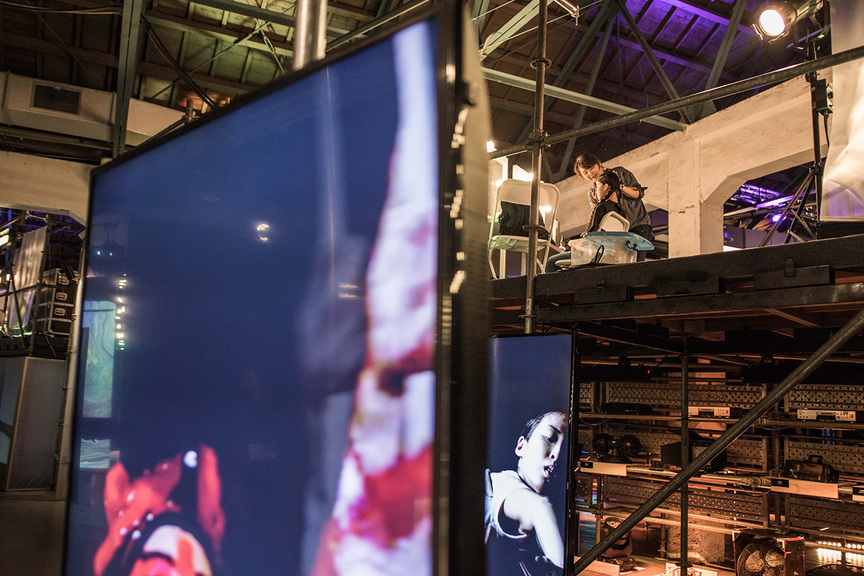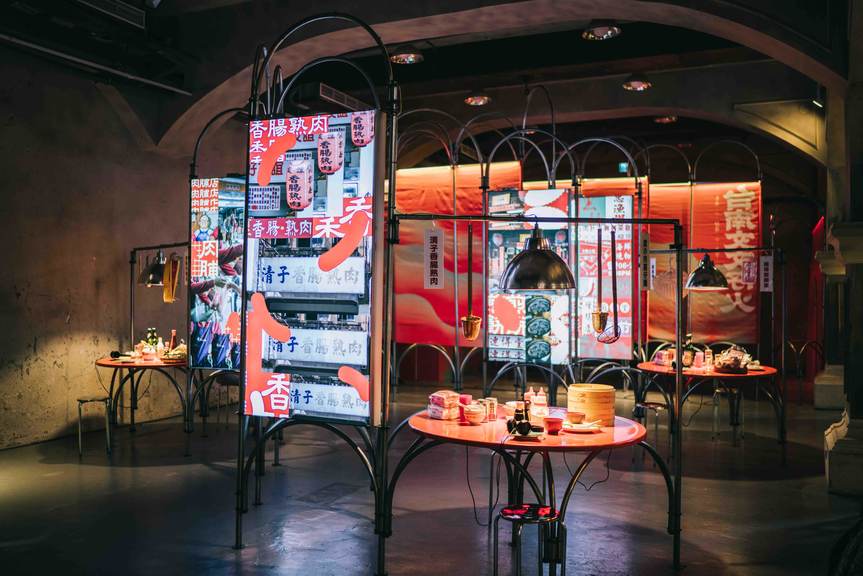
R
E
V N
E
X
T
Creative Expo Taiwan 2019 opened with a performance by local troupe U-Theatre. Photo by HEM MEDIA. Courtesy BIAS Architects, Taipei / Taoyuan.
At the opening ceremony for the ninth Creative Expo Taiwan (CET), a luminous, stationary palanquin greeted me at the entrance of the interconnected factory space at the east side of Taipei’s Huashan 1914 Creative Park. Encouraged by distant sounds of Chinese shanai horns and gongs, I walked into the venue and encountered a band rehearsal in one corner of the space and in another, a singer preparing for a performance at her vanity table. Thirty minutes later, the band, the singer and several other performers left their positions and came together, carrying the palanquin, on a small stage to perform traditional Taiwanese opera and contemporary drum performances. This opening event, organized by local performance troupe U-Theatre and under the program titled “Stage on the Move,” was a fitting introduction to this year’s 12-day CET, encapsulating an ancient Chinese proverb that describes how “one minute of performance on stage takes ten years of practice off the stage.”
CET 2019 was born out of a desire to highlight and preserve the traditional cultures of Taiwan, according to chief curator Tammy Liu Chen-Jung. Utilizing five locations along the new cultural corridor, which traces nine kilometers of the old Civic Boulevard railroad, this year’s iteration of CET aimed to explore Taiwanese identity through five programs of local arts and heritage. While “Stage on the Move” presented the performative history of Taiwan with workshops, acts by aboriginal dancers and artists, and local DJs, “Fair on the Move” assembled local and international designers, artists and independent cultural businesses across two venues at Songshan Cultural & Creative Park and Taipei Expo Park Expo Dome. The smaller “Infrastructure on the Move” at Taipei Railway Workshop teased the TRW Railway Museum, slated to open in 2026.
A highlight of CET was “Places on the Move,” also at Huashan 1914 Creative Park, which invited cultural practitioners from Taoyuan, Pintung, Taitung and Tainan to curate pavilions about their respective hometowns. The Tainan project, situated in a former winery and curated by Yu Chi-Wei, centered on southern Taiwan’s famous food culture and relaxing lifestyle. Multiple lightboxes featuring restaurant signboards emulated a typical street in Tainan, and tables decorated with chopsticks and bowls were embedded with headsets that played audio stories of famous dishes or street food in the region. Pingtung, a place known for its music and poetry, was illustrated with several multi-channel video installations featuring folk singers and contemporary poets singing or reciting their pieces, and a circle of colorful klick-klack tablets suspended from the ceiling recalled the changing colors of the seaside, forests, and paddy fields in Pingtung. Representing Taitung were piles of dry hay, transported from the area to Taipei and placed next to a series of objects collected by Taitung locals, such as slippers or motorcycle helmets. However, while these projects provided impressions on provincial culture, the pavilions were essentially anthropological presentations, and could have benefitted from more radical messages about possibilities for growth and preservation in the context of a modernizing Taiwan.
Also of note was “School on the Move,” which focused on marine cultures and the changing landscape of the island, and was organized by Contemporary Culture Laboratory (C-LAB), a cultural incubator located in Taipei’s Da’an district. As a way to remember the former irrigation systems and fields that once ran through the city, C-LAB transformed their badminton court into a temporary auditorium to accommodate performances by folk music bands and dancers, as well as talks and workshops on the ecology of the land, accompanied by an artificial shrimping pond—a once-common sight and activity that is disappearing due to urbanization—constructed for the event.
While somewhat tinged by localist anxieties—perhaps a result of the upcoming 2020 presidential elections—CET provided a much-needed alternative perspective into the identity of Taiwan, essentially rediscovering the island through the lens of culture.
Pamela Wong is ArtAsiaPacific’s assistant editor.
Creative Expo Taiwan 2019 runs from April 24 to May 5, 2019.



















